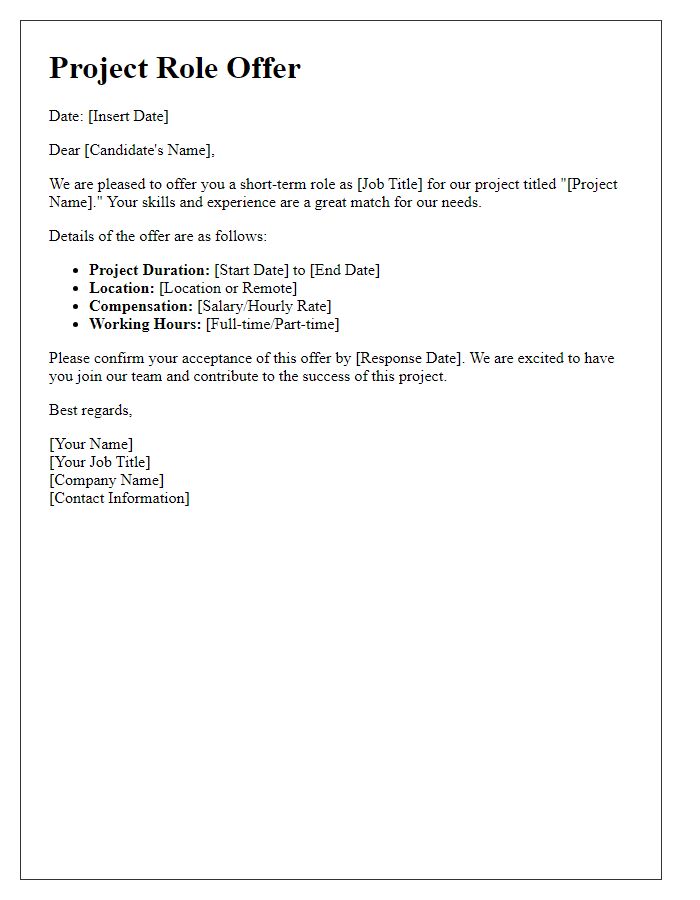Are you looking to craft the perfect project-based employment offer letter? It's essential to ensure that your communication is clear, friendly, and professional while outlining the specifics of the role offered. In this article, we'll guide you through the key elements to include in your letter, making it easier for both you and the potential employee to start on the right foot. So, let's dive in and explore how to write an effective project-based employment offer letter that stands out!

Clear Project Scope and Objectives
A detailed project scope outlines specific objectives and deliverables essential for successful project completion in project-based employment. Clear objectives establish a framework for measuring project performance, aiming for targeted outcomes and timelines. Deliverables, such as milestone reports and final presentations, provide tangible evidence of progress. Stakeholders, including project managers and team members, must understand their roles in achieving objectives. Clear communication channels and tools enhance collaboration and ensure alignment with project goals while addressing potential risks. Effective project scopes adapt to changing requirements, maintaining focus on the end goal.
Detailed Role and Responsibilities
Project-based employment entails a range of defined duties and expectations essential for the successful execution of specific tasks. The role typically includes responsibilities such as project planning, involving the creation of timelines and resource allocation, to ensure milestones are met effectively. Analysis of project requirements through stakeholder meetings ensures alignment with organizational goals. Execution of project deliverables requires a close collaboration with cross-functional teams, maintaining clear communication channels for progress updates. Monitoring progress entails regular evaluations against set benchmarks, adjusting strategies as necessary to meet deadlines. Reporting to project managers and stakeholders involves compiling detailed updates on project status, challenges encountered, and solution proposals. All activities must adhere to industry regulations and best practices, ensuring compliance throughout the project lifecycle. As employment is project-based, adaptability to shifting priorities and timelines is crucial for achieving successful outcomes.
Defined Compensation and Payment Terms
In project-based employment, clear compensation and payment terms ensure transparency and mutual understanding between the employer and the employee. For instance, a contract may specify an hourly rate of $50 for a 60-hour project, totaling $3,000, with payment scheduled bi-weekly upon milestone completion. Payment methods, such as direct deposit to bank accounts or checks, should be outlined. The timeline for completing tasks and submitting invoices, which could range from 14 to 30 days after project conclusion, is crucial. Additionally, terms regarding revisions or extra work must be stated, indicating how additional compensation will be calculated, such as at a rate of 1.5 times the standard hourly fee for overtime. Addressing taxation responsibilities for independent contractors, including the issuance of IRS Form 1099 for earnings over $600 annually, further clarifies roles in the financial arrangement.
Specific Duration and Timeline
Project-based employment offers typically outline specific duration and timeline details that are crucial for both the employer and employee. The contract may state a fixed term, such as six months or one year, clearly defining the project's start and end dates. For instance, a project focused on software development might commence on January 15, 2024, and conclude on July 15, 2024. Milestones could be established within this timeline, with deliverables due at regular intervals, such as bi-weekly progress reports or quarterly reviews. Additionally, any provisions for extending the project duration or transitioning to a permanent role should be articulated, ensuring transparency and alignment of expectations for all parties involved.
Confidentiality and Intellectual Property Clauses
Confidentiality and intellectual property clauses are critical components in project-based employment agreements. Confidentiality provisions typically stipulate that any sensitive information shared during the project, such as trade secrets, client lists, or proprietary methodologies, must remain undisclosed during and after the employment term. This ensures that competitive advantage is maintained. Intellectual property clauses define ownership rights over creations developed during the project, specifying whether the employer or the employee holds rights to inventions, designs, or software. For example, if a designer creates a unique logo for a brand during the project, the agreement should clearly state who retains the rights to that logo. Such clauses are essential in protecting both the interests of the employer and the creative contributions of the employee.













Comments